
Publicado en 6th Sep 2023
Modificado en 11th Sep 2023
Iniciando una colección de billetes británicos.
Siempre he sido coleccionista de "cosas" y he intentado muchas veces averiguar por qué. Tras años de reflexión interna y de estudio profundo, llegué a la conclusión de que debería dejar de intentar comprenderlo y volver a coleccionar.
La mayoría de nosotros hemos coleccionado alguna vez algo, o muchas cosas. Mi coleccionismo comenzó con llaveros cuando era niño y fue simplemente porque "no tenía uno de esos". Ahora que soy adulto, hay algunas cosas que colecciono y los billetes son una de ellas.
El objetivo de esta publicación es dar una pequeña explicación de los términos de coleccionismo de billetes y dar algunos consejos sobre el tema. Mi colección de billetes se centra en los billetes británicos del Banco de Inglaterra , por lo que estos son los que utilizaré como referencia, pero también se pueden utilizar en muchos otros países.
Los temas que cubriré son;
Cómo empezar una colección.
Cómo almacenar y cuidar una colección.
Calificación.
Notas alteradas, limpiadas y prensadas.
Términos y expresiones como Reemplazo, Ordenamiento por columnas, Primero y último, Cajero, RADAR, Debden, Números de referencia y Números de serie.
Errores y rarezas.
Más allá de la apariencia.
Cómo empezar una colección.
En términos simples, compre su primer billete y ya ha comenzado. Antes de hacerlo, piense en lo que lo llevó a coleccionar billetes y hacia dónde quiere que lleve su colección. ¿Se sintió atraído por los billetes de 10 chelines de Britannia de primera emisión (10/)? Si es así, comience por ahí. Si es más general, comience con un plan.
El primer paso sería comprar un buen libro, como la selección disponible en Coins-Auctioned.com . Los principales libros que se recomiendan son:
Papel moneda inglés: Vincent Duggleby, editado por Pam West. (Por cierto, Pam tiene un stock fantástico de billetes británicos).
Anuario de billetes: Token Publishing. Token Publishing también publica libros y revistas sobre monedas y medallas.
English Paper Money (EPM) enumera todas las variedades conocidas de billetes ingleses desde 1694 en adelante. También incluye una guía de precios, pero recuerde que es una guía y los billetes pueden costarle más o menos. No incluye billetes escoceses ni irlandeses.
El Anuario de Billetes (BNY) tiene una forma ligeramente más "flexible" de tratar todos los prefijos y variedades, lo cual no me gusta, pero sí incluye billetes de bancos irlandeses y escoceses, así como de las Islas del Canal y una sección sobre errores.
Comencé mi colección de una manera muy aleatoria, pero podrías comenzar de cualquiera de las formas a continuación o una combinación.
Empieza con un billete de cada denominación: 10/, £1, £5, £10, £20 y £50. No importa qué emisión o cajero, simplemente te dará algo con lo que puedas rellenar los huecos. A medida que avances, puedes ir añadiendo distintos cajeros o variedades de billetes.
Comience con una denominación en particular y diferentes variedades. Puede comenzar con una Serie A, Britannia, 10/, agregar una emisión de emergencia (tiempo de guerra) y luego una emisión posterior con retrato de la reina. A partir de allí, puede agregar diferentes cajeros para la misma denominación o diferentes números de serie. Luego, continúe ampliando esto con todos los números de prefijo o comience con diferentes denominaciones.
Asista a una feria o navegue en línea y comience con la pieza que le "hable".
O de cualquier manera que te resulte cómoda.
A partir de ahí se pasa a la completitud, las rarezas y las rarezas.
Cómo almacenar y cuidar una colección.
Al igual que sucede con el coleccionismo de monedas, el almacenamiento de una colección es un tema de debate. Lo mejor es empezar por cuidar la colección.
Manipule todos los billetes con cuidado. Use los dedos, no pinzas (en mi opinión personal), ya que los dedos son suaves y tienen menos probabilidades de rayar o marcar el papel. Antes de manipular cualquier billete, asegúrese de que sus manos estén limpias y secas. Esto es muy importante, ya que la suciedad puede afectar el estado de un billete de inmediato y con el tiempo. Las manos mojadas o húmedas pueden causar problemas con la laca del papel y provocar ondulaciones. Puede que esto no parezca gran cosa, pero puede afectar drásticamente al estado y al valor de un billete. Tómese su tiempo y sea paciente. He visto demasiados billetes dañados por personas que se apresuran a volver a guardarlos en los resguardos o carpetas. A menudo tengo un paño de microfibra como el que se muestra a continuación cerca cuando estoy manipulando billetes, solo para limpiarme los dedos y mantenerlos secos y sin grasa.
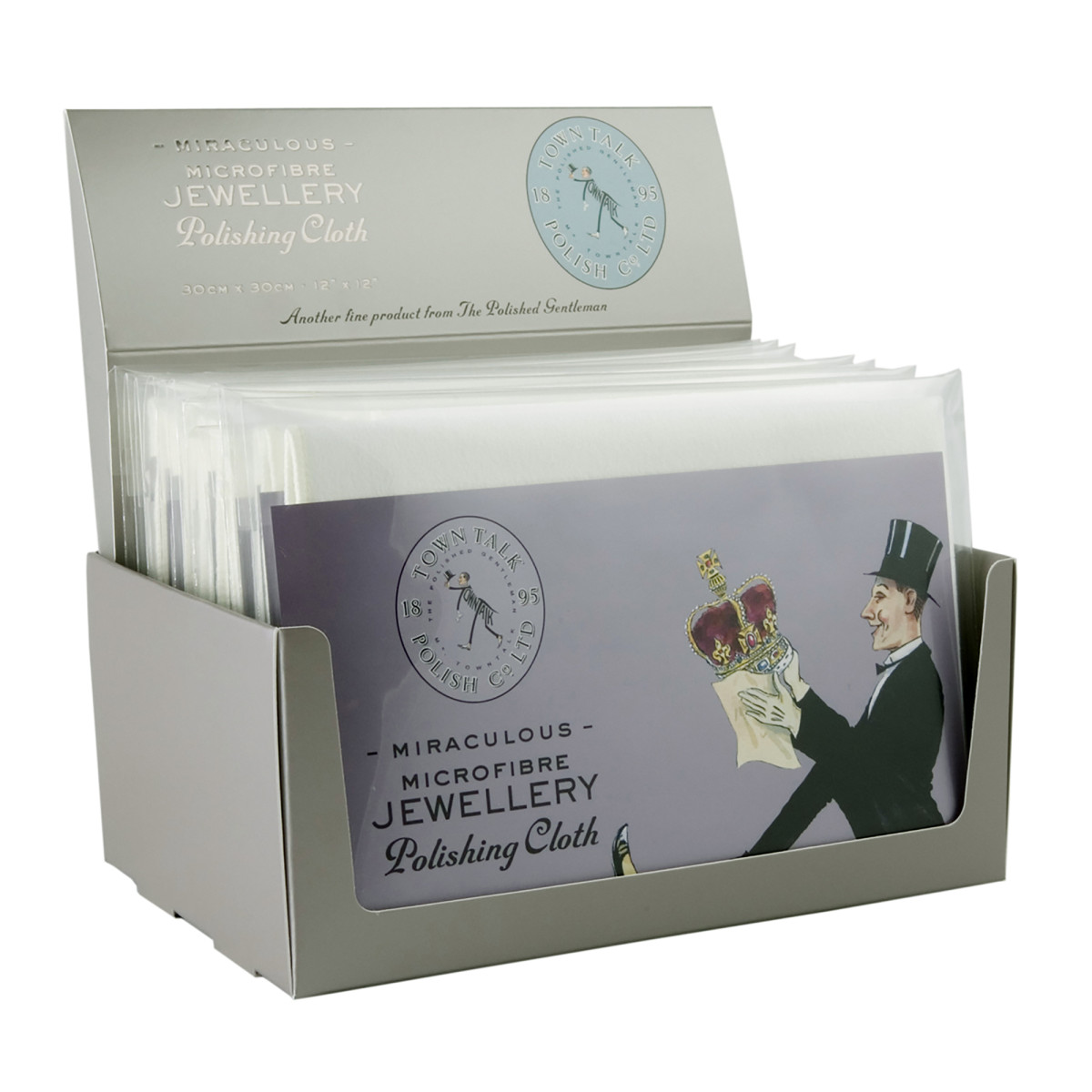 Los paños de microfibra son ideales para limpiar rápidamente sus manos al manipular billetes y, con cuidado, también se pueden utilizar para eliminar suavemente las marcas de dedos del papel moneda.
Los paños de microfibra son ideales para limpiar rápidamente sus manos al manipular billetes y, con cuidado, también se pueden utilizar para eliminar suavemente las marcas de dedos del papel moneda.
Almacenar una colección puede ser complicado. Hay muchos álbumes de billetes disponibles, así como resguardos, sobres, bolsillos y billeteras; el nombre depende de quién los venda. Lo importante es evitar el PVC con suavizantes. Esto es muy específico, pero hay una razón. El PVC suavizado libera gases con el tiempo que pueden hacer que los billetes se amarilleen y las monedas adquieran cardenillo. También puede hacer que los billetes sean un poco más quebradizos.
Suelo guardar toda mi colección en carteras de plástico y mi proveedor favorito es SAFE, pero por supuesto hay muchos otros. Asegúrate de que los tamaños que compres se ajusten cómodamente a tus billetes, ya que no querrás que queden apretados. Todas estas carteras deben mantenerse ordenadas y yo uso una caja fuerte para documentos como estas. Estas cajas no sustituyen a una caja fuerte o a un dispositivo de seguridad de alta resistencia, pero ofrecerán cierta protección contra el fuego y el agua, pero lo que me gusta es que también excluirán un poco la atmósfera y mantendrán mis billetes en buenas condiciones.
Conozco a muchos que guardan notas en billeteras y luego en álbumes para poder guardar más en un espacio más pequeño y mantenerlas protegidas.
Puede encontrar accesorios para su colección de papel moneda en Coins-Auctioned.com aquí
Calificación.
La clasificación es un tema difícil de entender para un principiante. La clave es ver muchos billetes y acudir a ferias cuando sea posible. Si hay un club local, vaya, ya que seguramente habrá gente ansiosa por mostrar y contar. Los comerciantes también estarán encantados de hablar sobre la clasificación. Un buen comienzo es echar un vistazo a las páginas de clasificación de la International Bank Note Society, que puede encontrar aquí . Se trata de un recurso muy útil, ya que el texto es mucho más útil que las imágenes.
Los grados básicos son;
Sin circular (SC): Billete en perfecto estado, sin usar, que no ha estado en circulación ni ha sufrido un mal manejo. Plano, nítido, con esquinas cuadradas, colores brillantes y con todo su lustre, si corresponde.
Casi sin circular (AUNC): prácticamente igual que el anterior, pero puede tener un ligero pliegue o marcas de conteo (imagínese a un empleado lamiéndose el dedo y contando una pila), pero nada más grave.
Extremadamente fino (EF): un billete de buen aspecto que puede tener hasta tres pliegues leves o un pliegue pronunciado. El papel y la tinta deben estar bonitos y brillantes con el brillo o lustre original. Se permite que las esquinas estén ligeramente redondeadas.
Muy bien (MBF): en general, se ve bien y todavía está un poco nítido, pero puede tener más pliegues, un poco más de redondeo en las esquinas, posiblemente algo de suciedad y manchas de tinta. Aún así, es un estado muy aceptable.
Bien (F): se está volviendo un poco flácida con más pliegues, suciedad y esquinas redondeadas. Puede haber algunos pequeños desgarros y desgaste en los bordes, pero no llegan al diseño principal. Unos pocos agujeros son aceptables.
Muy bueno (MB): muy usado, sin crujidos, bordes redondeados y desgastados. Posiblemente un pequeño agujero por haberlo doblado con fuerza o repetidamente. Los colores no serán tan vivos. La nota debe estar completa.
Buena (G): Muy desgastada, muy circulada y sin vida. Múltiples pliegues, arrugas, manchas, agujeros de alfiler, suciedad, agujeros de grapas, agujeros por doblado, pequeños desgarros. A menudo está escrita. No puede faltar ningún trozo grande del billete.
Aceptable (F): Igual que el anterior, pero peor. Es posible que falten piezas, haya más escritura, suciedad, etc.
Pobre (PR): Sí, ahora estamos en el área de ser buenos para el papel artesanal y no mucho más. Todo lo anterior, pero peor. Se podrían pegar juntos, recortar, básicamente todos los puntos malos. Las únicas razones para tener estos en tu colección es si son muy raros o si estás manteniendo el lugar abierto para un mejor ejemplar.
Intentaré poner algunas fotografías de estas calificaciones cuando pueda, pero probablemente omitiré cualquier cosa por debajo de VG, ya que no las veo a menudo.
Lo que siempre hay que recordar es que la calificación es una opinión subjetiva. Lo que yo creo que es AUNC, otra persona puede pensar que es UNC y otra puede pensar que es EF+. El "+" plantea otro punto a tener en cuenta (perdón por el juego de palabras). Muy a menudo, dos notas obtienen la misma calificación, pero una parece mucho mejor o peor que la otra. Aquí es donde entra en juego el "pero es casi un EF, mucho mejor que un VF". No es raro ver EF+, mejor que EF, pero no exactamente AUNC o AVF, es decir, casi VF.
Existe una tendencia a que los billetes (y monedas) sean calificados por terceros, algo que en general no me gusta. Muchas veces, las piezas están selladas en billeteras o estuches, lo que elimina parte del placer de coleccionar billetes, y eso implica manipularlos (con mucho cuidado, por supuesto). Estas empresas están ahí para ganar dinero y muchas califican de manera "suave" para garantizar más clientes habituales. En mi opinión, este ámbito tiene un largo camino por recorrer.
Notas alteradas, limpiadas y prensadas.
¿Qué son estos? Primero, tratemos los aspectos de limpieza y prensado. La limpieza consiste en lavar o pasar un paño por encima de un billete con la intención de mejorar su apariencia. Esto puede hacer que un billete VF parezca un billete EF si se elimina un poco de suciedad. Lo que suele hacer es quitar la laca original del billete y darle un acabado muy mate. El prensado consiste en aplanar un billete ya sea con presión, como una pila de libros, o con calor y presión, como una plancha. Nuevamente, esto se utiliza para mejorar la apariencia general de un billete.
Siempre que se limpie o se presione una nota, se debe indicar. Lo que parece un grado podría ser uno o dos grados más bajo y el valor también podría ser uno o dos grados más bajo.
Con la experiencia será más fácil detectar si algo anda mal con un billete. Lo que hay que buscar son billetes UNC con esquinas desafiladas, probablemente limpiados y prensados. Falta de barniz o laca en algunos papeles, limpiados y/o prensados en caliente. Lo que debería estar impreso en relieve (como el Banco de Inglaterra en muchos billetes) está plano, prensado, ya sea en caliente o en frío. La experiencia te dirá más.
Billetes alterados: en los muchos años que llevo coleccionando, he visto muchas alteraciones para que las piezas parezcan más valiosas. He visto los resultados de personas que presionaban en caliente un dígito adicional en el número de serie para convertirlo en un "error raro", induciendo o reduciendo la fluorescencia del papel para generar "errores" y muchas otras cosas. También hay muchas falsificaciones, algunas de las cuales son coleccionables por derecho propio. El desarrollo más preocupante de los últimos años es la cantidad de billetes de polímero "erróneos". Un determinado sitio de subastas mundial tenía listado tras listado de billetes de polímero de £5 "erróneos" raros. Elizabeth Towers faltantes (lo que muchos consideran el Big Ben), un ojo faltante, denominación faltante, etc. estaban por todas partes. ¿Cómo lo arruinó tanto el Banco de Inglaterra? No lo hizo. Mucha gente se quedó sentada en casa con bastoncillos de algodón y acetona (quitaesmalte de uñas) frotando partes del diseño. Mi consejo sobre los errores en los billetes de polímero es que ni siquiera consideres uno a menos que sea algo adicional en lugar de algo que falta.
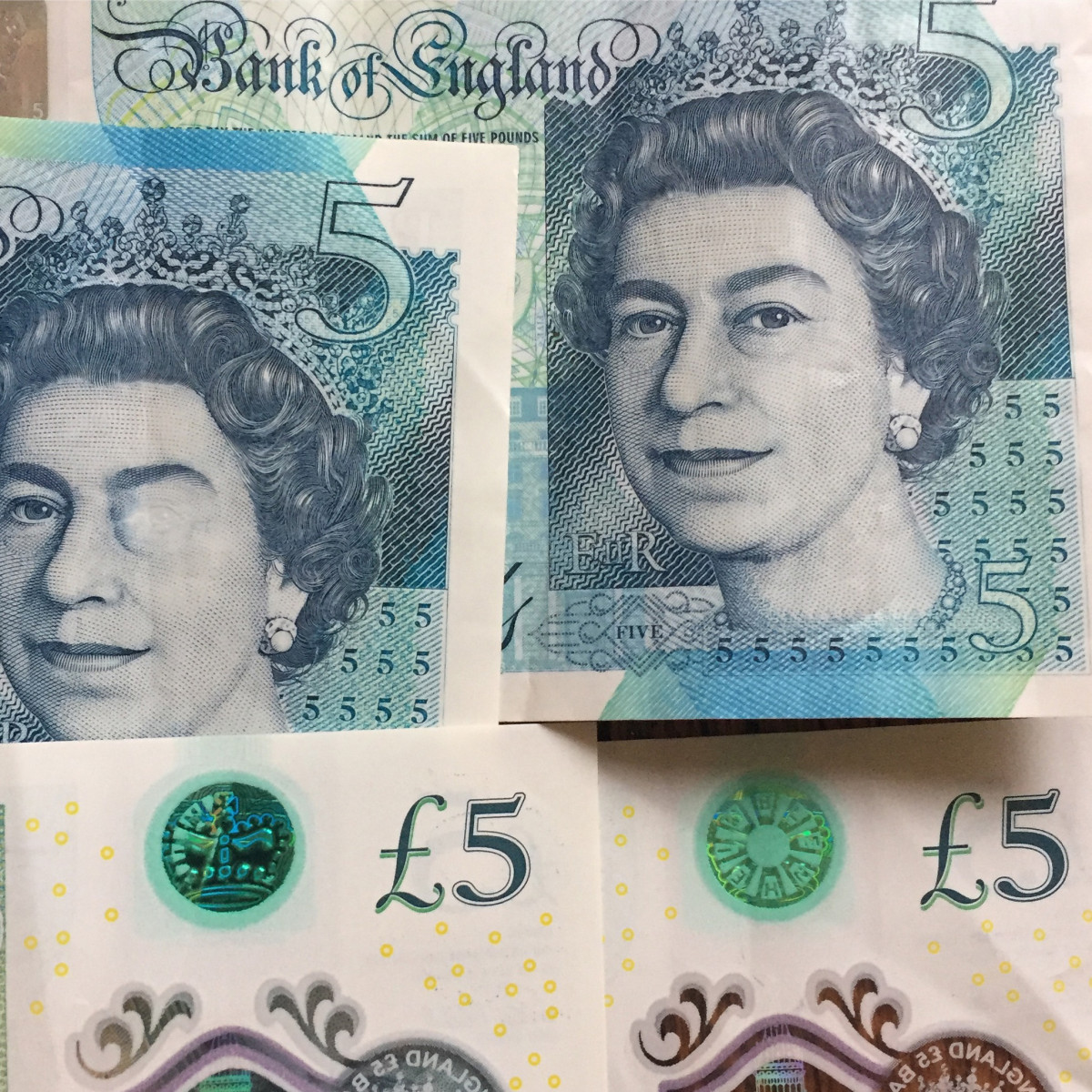 Dos billetes de polímero falsos de 5 libras con errores. "Errores de imprenta" (izquierda). Falta un ojo y el dispositivo sobre la corona holográfica. Ambos fueron alterados con acetona y no son errores genuinos.
Dos billetes de polímero falsos de 5 libras con errores. "Errores de imprenta" (izquierda). Falta un ojo y el dispositivo sobre la corona holográfica. Ambos fueron alterados con acetona y no son errores genuinos.
Términos y expresiones.
Algunas de ellas son sencillas y fáciles, otras son un poco más complicadas.
Cajero: El Banco de Inglaterra designa a un cajero jefe y su firma aparece en cada billete emitido durante su mandato. Así de simple. Hay una excepción notable: se omitió la firma de David Henry Fitzroy Somerset (DHF Somerset) en una emisión de billetes de 5 libras (Duggleby/EPM B343a, BNY BE114).
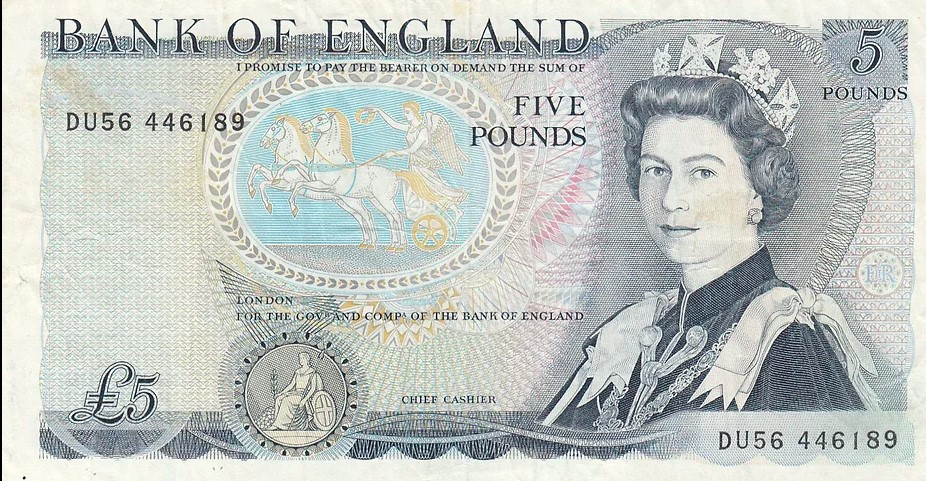
EPM 343a Billete DHF Somerset de £5 sin firma.
Número de serie: todos los billetes emitidos (la mayoría de ellos) deben tener impreso su propio número de serie único, de forma muy similar a la matrícula de cada automóvil. Esto es para fines de identificación y registro. Es importante prestar atención a los números de serie, ya que aquí es donde entran en juego los reemplazos, las clasificaciones por columnas, las palabras, el RADAR y la identificación de series. En los billetes del Banco de Inglaterra, los prefijos de serie, la primera sección de los números, suelen seguir uno de los siguientes formatos:
Letra, Número, Número: p. ej. X41
Número, Número, Letra: p. ej. 41X
Letra, Número, Número, Letra: p. ej. C01N (una especial, mira las palabras)
Letra, Letra, Número, Número: p. ej. AN01
Los billetes del Tesoro tenían números de serie con una letra o un número encima de un número o una letra, por ejemplo, B sobre 50 o 99 sobre B.
Nombre y apellido: son muy sencillos. Cuando se imprime un billete nuevo (de un cajero o tipo nuevo), comienza con un prefijo de número de serie particular; por ejemplo, un billete de £5 de Gill comenzaba con RD01 (primera tirada); RD25 sería la primera serie. Los últimos billetes impresos tenían el prefijo de serie SE90 (última tirada) y SE25 sería la última serie.
Reemplazo: Cuando se imprimen billetes, se imprimen en hojas grandes y luego se cortan. Cada billete de una hoja tendrá un número de serie diferente que ayuda a llevar un registro de cuántos y qué se están imprimiendo. Si una hoja se estropea, se imprime mal, etc., debe eliminarse y destruirse e insertarse una nueva hoja de billetes de reemplazo. Los reemplazos tienen un número de prefijo diferente para ayudar a identificarlos cuando se verifican los registros, pero los números serían los mismos que los de la hoja destruida. Los billetes de reemplazo generalmente tienen precios más altos porque son más raros que los de las emisiones estándar. Los prefijos que se pueden buscar fácilmente son "M" y "LL". Los billetes anteriores a 1948 tenían un formato más complejo.
Clasificación por columnas: cuando De La Rue se hizo cargo de la impresión, intentaron reducir los desperdicios por errores de impresión. En lugar de descartar toda la hoja para conservar unas pocas notas, cortaron las notas que estaban bien y las clasificaron en columnas para imprimirlas con nuevas publicaciones periódicas. Los números de clasificación por columnas tienden a verse extraños, ya que están fuera del rango de números normal.
Seriales “Especiales”: Números de Serie que son más que la suma de sus partes;
RADAR: La versión numérica de un palíndromo (como el radar). Por ejemplo: 543212345
Palabras: Es posible encontrar palabras en series como el formato Letra, Número, Número, Letra que da C01N, R01L, C01L, etc. C01N es uno de los que me resulta particularmente agradable.
Seriales sólidos: un número único que se repite, como Prefijo, y luego 33333333
Millones de números seriales: prefijo 1000000 o 2000000, etc.
Técnicamente, ninguna de estas monedas es más rara que las demás. Tengo una B32N de 10 chelines de la que solo hay una, igual que mi C01N, que es un poco peor, pero la C01N es más deseable.
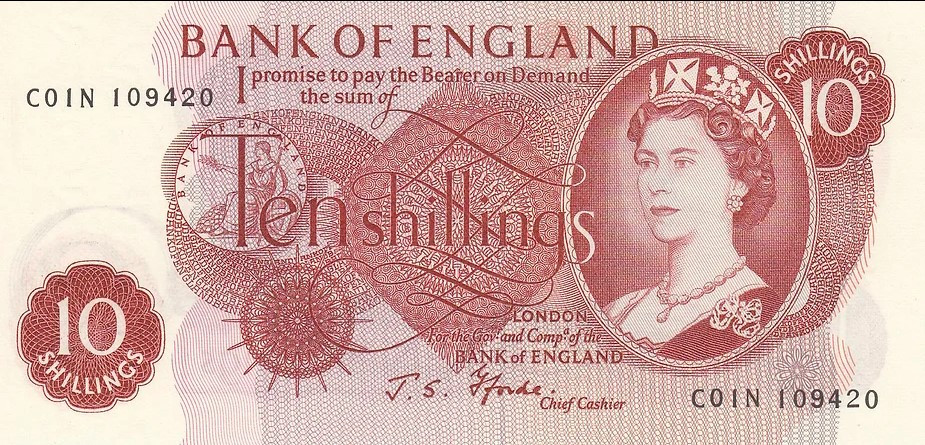
Nota "C01N".
Series de Debden: Debden Security Printing emitió una serie de series de billetes y tengo que admitir que todavía estoy un poco confundido con ellas. Algunas eran series de "última serie" y luego se encontraron series más altas en circulación. Algunas eran series coincidentes, como £5 y £10 con 999500 como serie, etc., lo cual es bastante genial. En resumen, las series se emitieron para obtener más (bastante más) que el valor nominal y producir un artículo coleccionable. No creo que se pueda crear un artículo coleccionable, el mercado decide si lo es.
Errores y rarezas:
Aquí es donde las cosas se ponen interesantes y, a menudo, muy caras. ¿Qué es un error? Un error es un defecto no intencional y, por lo general, único. Ahora bien, esto no es como en el caso de las monedas, donde muchas personas usan el término error para referirse a la variedad. Los errores en los billetes tienden a ser individuales. Los errores no son comunes; leer sobre reemplazos y ordenamientos de columnas más arriba debería dejarlo claro.
Entre las rarezas se encuentra la cantidad de experimentos y ensayos. Se han probado distintos métodos de impresión, papeles y características de seguridad en determinados momentos, pero necesariamente se han adoptado como normales. Busque distintos papeles, como "notas R" (con una R minúscula en el reverso), etc.
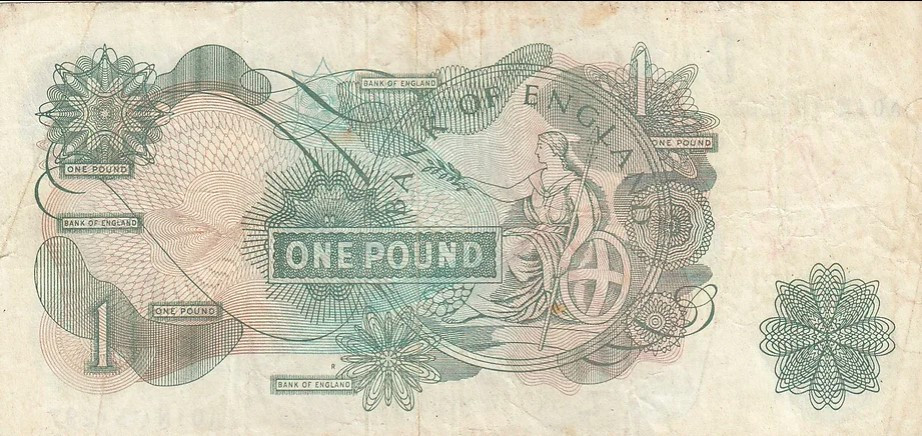 Nota con la letra "R". Con una R pequeña encima de BANK OF ENGLAND cerca de la parte inferior. Esto indica una nota de investigación. El tipo de R puede variar y espero poder cubrirlos en una publicación posterior.
Nota con la letra "R". Con una R pequeña encima de BANK OF ENGLAND cerca de la parte inferior. Esto indica una nota de investigación. El tipo de R puede variar y espero poder cubrirlos en una publicación posterior.
¿Qué son los errores? ¿Qué es probable que veas?
Errores de impresión, como áreas impresas demasiado oscuras, ambos lados de un billete impresos en un solo lado, falta de un color, manchas, falta de impresión, impresión en un pliegue o arruga (franja de impresión faltante), objetos extraños que oscurecen la impresión. Como mencioné anteriormente, tenga cuidado con los billetes de polímero modernos. No creo haber visto una impresión genuina faltante en uno todavía.
Los números de serie también presentan problemas para las impresoras: el mismo número de serie en un par de billetes, números de serie faltantes, 2 números de serie diferentes en el mismo billete, falta un dígito, impresión incorrecta (por ejemplo, medio 1 sobre medio 2), la lista continúa.
Los errores de corte incluyen papel adicional, como cuando una pieza se dobla antes de guillotinarla, desalineación con una nota cortada demasiado alta o demasiado baja, desalineación total con la mitad de cada una de 2 notas.
 Un error de corte de "aleta de tiburón". La esquina de la hoja se dobló antes de cortar, dejando este trozo extra. Esto es mucho menos común en los billetes más recientes. Un billete como este me sorprende, ya que imagino que la mayoría lo recortaría y lo usaría, especialmente cuando se considera lo que se podía comprar con 10 chelines en ese momento. 1 chelín equivalía a 12 peniques (12 peniques antiguos), por lo que 10 chelines eran 120 peniques (120 peniques antiguos) y en 1948 se podían comprar 12 libras (lbs) de queso con eso. En el dinero actual, 12 libras de queso cheddar costarían alrededor de £ 45, por lo que se podría decir que era el equivalente a que alguien escondiera un billete de £ 50.
Un error de corte de "aleta de tiburón". La esquina de la hoja se dobló antes de cortar, dejando este trozo extra. Esto es mucho menos común en los billetes más recientes. Un billete como este me sorprende, ya que imagino que la mayoría lo recortaría y lo usaría, especialmente cuando se considera lo que se podía comprar con 10 chelines en ese momento. 1 chelín equivalía a 12 peniques (12 peniques antiguos), por lo que 10 chelines eran 120 peniques (120 peniques antiguos) y en 1948 se podían comprar 12 libras (lbs) de queso con eso. En el dinero actual, 12 libras de queso cheddar costarían alrededor de £ 45, por lo que se podría decir que era el equivalente a que alguien escondiera un billete de £ 50.
También surgen errores varios, incluidos hilos de metal que no están cuando debería haberlos, marcas de agua faltantes o adicionales, hilos de metal desalineados y cualquier otra cosa que se te ocurra que pueda haber salido mal.
Un consejo muy importante a la hora de ver billetes mal cortados (demasiado altos o demasiado bajos) es comprobar el tamaño. He perdido la cuenta de la cantidad de personas que han comprado un "error" en el que alguien ha recortado el borde.
Entre las rarezas se encuentran los numerosos ejemplares, réplicas, billetes de propaganda y falsificaciones, algunos de los cuales son muy coleccionables por sí mismos. Es muy interesante ver falsificaciones contemporáneas junto a un billete auténtico para ver qué impulsó la necesidad de innovación en la seguridad de los billetes. Los billetes de la Operación Bernhard son falsificaciones, pero son muy coleccionables por sí mismos, y a menudo alcanzan precios tan altos como los billetes auténticos. No suelo enviar a la gente a Wikipedia para obtener información, pero el artículo sobre Bernhard es bastante correcto.
Más allá de la faz de la misma.
Si empiezas a coleccionar billetes, debes tomarte el tiempo necesario para mirarlos, y me refiero a mirarlos REALMENTE. Cada billete es una obra de arte. Cada línea de un billete antiguo era originalmente una línea grabada a mano; tómate el tiempo necesario para apreciarla. Compara el brillo de los billetes, el idioma, los cambios sutiles de color, utiliza diferentes fuentes de luz para apreciar las marcas de agua y las marcas ultravioleta. Si te tomas el tiempo, hay mucho más para ver.
Artículo escrito originalmente por Damian J Miles y reproducido con permiso.
Buscar en el Coin Encyclopedia
Subastas relacionadas
Artículos relacionados
Infórmese sobre las distintas denominaciones de las monedas romanas en Coins-Auctioned.com ¿De qué están hechas? ¿Cuánto pesan? ¿Qué tamaño tienen? Encuentre las respuestas en Coins-Auctioned.com.
30th Oct 2023
Conmemorando una victoria: el tetradracma de Demetrio con Neptuno y proa Demetrio era hijo de Antígono, uno de los generales de Alejandro Magno. El apodo de Antígono era Monoftalmos o "un ojo".
19th Oct 2009
¿Cuáles son las mayores dominancias en billetes del mundo en la actualidad? Descubre lo que Francia, el Reino Unido y los EE.UU. han puesto en sus billetes más grandes
10th Apr 2018
últimos artículos
Los centavos grandes son monedas de cobre de un centavo acuñadas entre 1793 y 1857, algunas de las primeras monedas oficiales estadounidenses. Entre los tipos más destacados se encuentran los centavos de corona y los de cadena. ¡Aprenda los tipos, valores e historia de los centavos grandes!
11th Jul 2025
Las fichas de tiempos difíciles son monedas no oficiales creadas por empresas privadas estadounidenses durante la depresión económica de la década de 1830. ¡Descubre la historia, los diseños rebeldes y el valor de las fichas de tiempos difíciles aquí!
18th Jun 2025
Los dólares presidenciales son monedas estadounidenses que representan a cada expresidente fallecido, emitidas entre 2007 y 2020. Descubra los antecedentes, los detalles y las valiosas variedades de los dólares presidenciales en esta guía.
5th Jun 2025
Categorías de artículos
Collection of articles providing lots of useful information on coins through the ages.
30 Artículos




